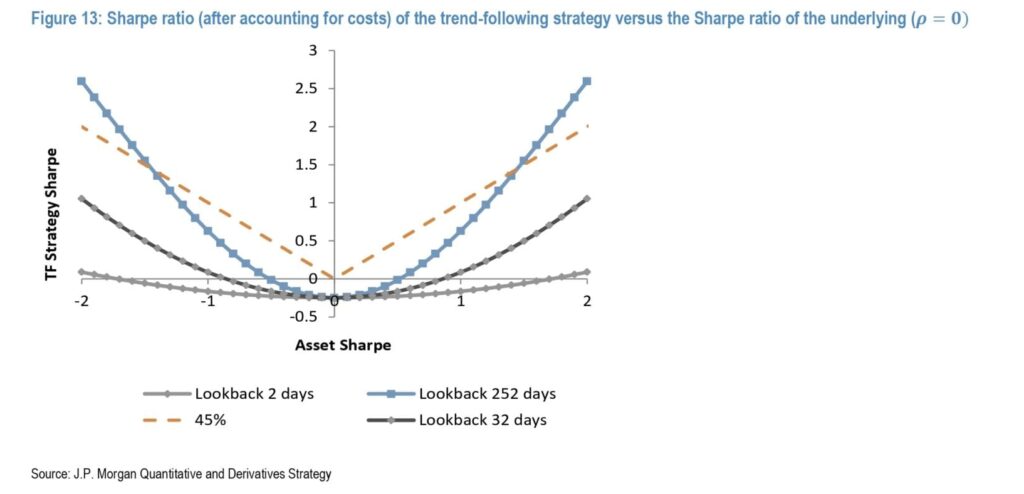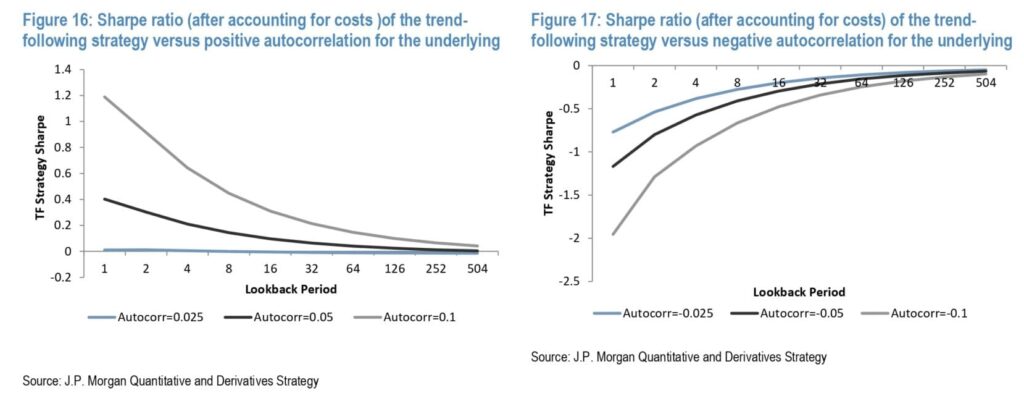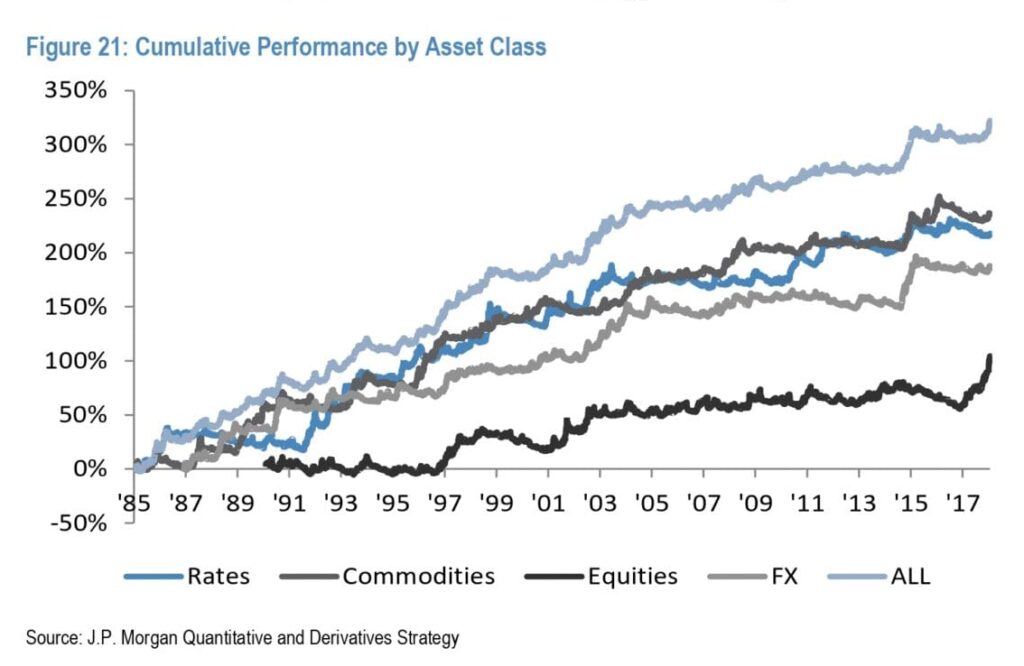Designing Sturdy Development-Following System
It’s not straightforward to construct a strong trend-following technique that can face up to completely different tough market circumstances and convey constant outcomes. The writer of in the present day’s work was not frightened by this activity and delivered a full framework on find out how to design a strong trend-following technique step-by-step.
The strategy presents sensitivity evaluation and robustness checks by means of varied time horizons and pattern selections. It additionally accounts for transaction prices (when one rebalances usually, they creep in and eat out a major chunk of earnings) and takes a multi-asset method to maximise intently watched threat metrics from PMs (portfolio managers).
Dobromir Tzotchev’s framework may be summarized into the next steps:
Want for a clear Development-following Sign: The paper proposes a trend-following time-series momentum sign primarily based on statistical principle and investigates its properties. It reconciles theoretical outcomes with stylized details about trend-following investing, together with the hyperlink to straddles and the higher efficiency of so-called “slower” indicators.
Sound Design and Prototype Resolution: Primarily based on theoretical outcomes, the paper introduces a prototype trend-following answer that makes use of a unified method throughout property and diversifies throughout time frames. By simulation examples, it highlights efficiency versus benchmarks and diversification properties for long-only portfolios.
Threat Administration Strategies: The paper elaborates on portfolio and threat administration for trend-following methods. It adapts risk-budgeting and Hierarchical Threat Parity (HRP) approaches to the trend-following framework. Moreover, it discusses strategies to handle transaction prices and implications of the carry element in futures and FX forwards.
Authors: Dobromir Tzotchev
Title: Designing Sturdy Development-following System: Behind the Scenes of Development-following
Hyperlink: https://papers.ssrn.com/sol3/papers.cfm?abstract_id=4677166
Summary:
Development-following has actively been on buyers’ radar for the previous couple of a long time. The J.P. Morgan primer on momentum methods (Kolanovic and Wei, 2015) supplies an in depth evaluate of the momentum methods. The present paper focuses on a concrete trend-following answer and analyzes its properties alongside the sensible implementation.
As all the time we current a number of attention-grabbing figures and tables:





Notable quotations from the tutorial analysis paper:
“We begin by presenting a sign that’s primarily based on statistical speculation testing. We present that underneath sure circumstances the trend-following sign is the additionally the delta of a straddle. Therefore we make express the extensively propagated hyperlink between trend- following and lengthy straddle positions (see for instance Fung and Hsieh 2011).Subsequently, we analyze the revenue drivers for the trend-following technique primarily based on the proposed sign. We present that the technique (equally to a straddle) is worthwhile each time there are developments in both course. Therefore we exhibit that the so-called “CTA smile” (see for instance Hurst et. al. 2014) may be justified inside a theoretical mannequin as nicely. Moreover, the technique displays convexity. Absolutely the worth of the Sharpe ratio of the underlying asset is of essential significance for the profitability of the technique and the upper the quantity, the larger the convexity embedded within the technique. Moreover, indicators primarily based on longer estimation durations possess ceteris paribus higher profitability than indicators primarily based on shorter lookback durations.Subsequent, the time-series properties of the underlying asset are explicitly taken into consideration. We present that the autocorrelation is vital just for the profitability of indicators primarily based on brief lookback durations (usually lower than a month). Naturally constructive autocorrelation results in earnings whereas even small values of detrimental autocorrelation induce substantial losses. However the profitability of the indicators primarily based on longer lookback durations is unaffected by the time-series properties of the underlying.
Because of the non-linear nature of the expressions for the anticipated P&L and transaction prices, it’s tough to derive the edge Sharpe ratio of the underlying that renders the profitability of a sign primarily based on a sure lookback interval. Nonetheless, numerical outcomes shed some attention-grabbing caveats for this relationship. In Determine 13 we have now plotted the Sharpe ratio primarily based on the web P&L of the trend-following technique versus the Sharpe ratio of the underlying for varied lookback durations. We use the transaction value construction for S&P and assume a each day volatility of 1% (roughly 16% annualized). It’s evident that indicators primarily based on brief time period lookbacks can solely be worthwhile if the Sharpe ratio of the asset is sort of sizable in both course. For instance, for a sign primarily based on 2 days we’d like a Sharpe ratio above 2 and beneath -2 to guarantee the profitability of the technique. For a sign primarily based on 32 days, the Sharpe ratio needs to be above 1 or beneath -1. Even a sign primarily based on a 1 12 months lookback interval requires absolutely the worth of the Sharpe ratio to be greater than 0.5 in order that profitability is assured.
Moreover, we count on the Sharpe ratio of trend-following technique to be beneath absolutely the worth of the Sharpe ratio of the asset. A large constructive or detrimental Sharpe ratio of the underlying and long run lookback interval are each obligatory for the Sharpe ratio of the trend-following technique to exceed absolutely the worth of the Sharpe of the underlying. For instance, we’d like the Sharpe ratio of the underlying to be greater in absolute worth than 1.5 in order that trend-following is extra worthwhile than both holding or shorting the asset.If the drift of the asset is secure (stays fixed over an extended interval), it’s rather more worthwhile and cost-efficient to make use of indicators primarily based on longer lookback durations. For instance, if we count on equities to exhibit a constructive drift as a result of embedded fairness threat premia, it’s preferable to make use of indicators with longer lookback durations. The attraction of the shorter time period lookback durations arises in two eventualities. Firstly, the length of the pattern could be smaller than an extended lookback interval. For instance, if the pattern adjustments course each 6 months making use of a sign primarily based on 1 12 months lookback might be detrimental. Secondly, throughout market reversals indicators primarily based on shorter lookback durations are extra reactive and finally mitigate the drawdowns of the slower trend-following programs.
[On Figure 21: Cumulative Performance by Asset Class] the cumulative efficiency of the benchmark method in varied asset courses in addition to the efficiency of the mixed portfolio are shown14. Commodities have traditionally had essentially the most interesting trend-following track-record (commodities are additionally the asset class upon which the CTA trade originated). The asset class that has been traditionally been essentially the most difficult for the trend-following method is equities.
Along with the enticing function of constructive skewness that the trend-following methods possess, trend-following methods carry substantial diversification advantages for the long-only portfolios. As we have now already proven within the theoretical sections, trend-following methods exhibit convexity and when the transfer on the draw back is sizable sufficient the return of the trend-following technique will greater than compensate the loss within the underlying. It has additionally been well-known that the magnitude of the sell-offs is usually fairly sizable and subsequently the offset with the trend-following methods is sort of interesting.To confirm this speculation empirically we have now constructed portfolios that include lengthy positions within the underlyings from our asset universe. The portfolios are nicely focused to have an annualized volatility of 10% and make the most of the identical threat weights for the person property as in our benchmark answer. We’ve additionally constructed mixed portfolios that make investments 50% within the long-only portfolio and 50% within the trend-following system. The diversification advantages are fairly evident in all asset courses apart from fastened revenue. In fastened revenue, the directionality of the market has led to a whole lot of overlap between the positions of the trend-following system and people of the long-only portfolio.”
Are you searching for extra methods to examine? Join our e-newsletter or go to our Weblog or Screener.
Do you wish to study extra about Quantpedia Premium service? Test how Quantpedia works, our mission and Premium pricing provide.
Do you wish to study extra about Quantpedia Professional service? Test its description, watch movies, evaluate reporting capabilities and go to our pricing provide.
Are you searching for historic information or backtesting platforms? Test our listing of Algo Buying and selling Reductions.
Or comply with us on:
Fb Group, Fb Web page, Twitter, Linkedin, Medium or Youtube
Share onLinkedInTwitterFacebookConfer with a pal



